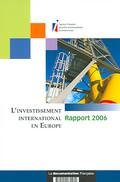 Publisher : AFII/La documentation française, june 2006
Publisher : AFII/La documentation française, june 2006
Author : Fabrice Hatem
An accurate evaluation of the mobile Foreign Direct Investment (FDI) market is becoming increasingly important in the face of competition between different countries to attract multinational company development projects. Statistics gathered by the Invest in France Agency’s « Monitors », which are based on investment projects in Europe, can provide valuable information on the subject
An analysis of the figures for 2002-2005, reveals the following conclusions:
1. The mobile FDI market in Europe accounted for 2 500 development projects and a minimum of 165 000 jobs per year.[1] There was a significant increase in the number of projects from 2002 onwards, and the numbers of jobs created increased in 2005 after three years stability.
2. The biggest source of investment projects, again in numbers of jobs created, is by far Western Europe, followed by North America. The contribution in terms of job creation resulting from investment from Asia is more limited, but showed a significant increase in 2005. There is a certain amount of diversity in investment profiles according to the country of origin: the trend towards massive relocation to Eastern European countries by the German manufacturing industry, is in contrast for example to the sustained high levels of investment in Western Europe by American companies based in the services and high tech industries.
3. In terms of job creation, investment is dominated by development projects in manufacturing and production (70.8% in total). However, the tertiary support services sector rates higher in terms of project numbers (62.9%). The difference between the two figures can be explained by the much larger unit size of development projects in the production sectors.
4. The automotive and electronic equipment sectors together account for some 38.7% of job creation. However, in recent years this contribution has declined in favour of the services sector and software industries.
5. Countries in Western Europe won more that three quarters of TNC investment projects in Europe between 2002 and 2005. These countries maintain a strong position with regards to high value added services and innovative sectors, as well as activities where location is dependent on geographical proximity to the market served.
6. Eastern European countries have benefited from increased numbers of manufacturing and production development projects, particularly in the automotive and other manpower-intense industries. Subsequently, these countries attracted more than half of the international jobs created by TNC’s in Europe between 2002 and 2005. This high proportion should however be offset against the fact that the average content of these jobs in terms of qualifications and value added is significantly less than for jobs created in Western Europe (factory worker v. engineers, researchers and executives).
These results should be situated within a more global context, a worldwide dimension. The analysis of statistics gathered from outside sources shows that Western Europe remains the main location for inward foreign direct investment flows measured in financial terms, but is overtaken by Asia in terms of numbers of jobs created
For a working paper of this study, please click on the following link :
/fh-medias/2012/05/rapport_anglais_2006_enm.doc
Tu download the complete report (in french) : /2006/07/13/rapport-sur-l-investissement-international-en-europe-2002-2005-edition-2006/
——————————————————————————-
[1] On the basis of partial accounting of jobs created per project. Surveys and evaluations carried out lead to an estimation of a 60% cover rate by the monitors in terms of jobs.